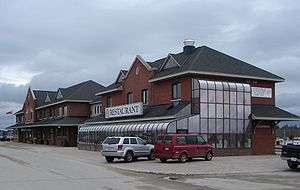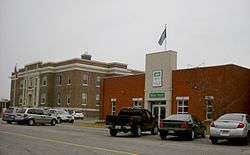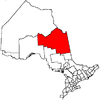Cochrane, Ontario
| Cochrane | |
|---|---|
| Town (single-tier) | |
| Town of Cochrane | |
|
Cochrane as seen across Lake Commando | |
 Cochrane | |
| Coordinates: 49°04′N 81°01′W / 49.067°N 81.017°WCoordinates: 49°04′N 81°01′W / 49.067°N 81.017°W | |
| Country |
|
| Province |
|
| District | Cochrane |
| Settled | 1908 |
| Incorporated | January 1, 1910 |
| Government | |
| • Mayor | Peter Politis |
| • Governing Body | Cochrane Town Council |
| • Federal riding | Timmins—James Bay (Charlie Angus, NDP) |
| • Prov. riding | Timiskaming—Cochrane (John Vanthof, NDP) |
| Area[1] | |
| • Land | 539.02 km2 (208.12 sq mi) |
| Elevation[2] | 274.90 m (901.90 ft) |
| Population (2011)[1] | |
| • Total | 5,340 |
| • Density | 9.9/km2 (26/sq mi) |
| Time zone | EST (UTC-5) |
| • Summer (DST) | EDT (UTC-4) |
| Area code(s) | 705 |
| Website | www.cochraneontario.com |
Cochrane is a town in northeastern Ontario, Canada. It is located east of Kapuskasing, northeast of Timmins, south of Moosonee, and north of Iroquois Falls. It is about a one-hour drive from Timmins, the major city of the region. It is the seat of Cochrane District. The town's population is made up of approximately half anglophone and half francophone residents.
The town contains many references to polar bears. Its mascot is a large polar bear statue known as Chimo. There are also live polar bears at the Polar Bear Conservation and Educational Habitat and Heritage Village, which opened in the summer of 2004. Polar bears from the Metro Toronto Zoo were relocated to Cochrane while a new pavilion was being constructed. Those two polar bears were returned to the Toronto Zoo in the summer of 2009.[3] In late May 2012, a new bear arrived at the Polar Bear Habitat, Ganuk. Also in 2012, a second bear, Inukshuk, was brought from the Toronto Zoo to The Polar Bear Habitat as a part-time resident. He is returned to the Toronto Zoo for a few months every year for breeding purposes.[4]
History
Before Cochrane was founded, it was already used as a summer camp ground by the indigenous people, and a stopping place for fur traders traveling to Moose Factory. In the early 20th century, the National Transcontinental Railway was built through the area, and in 1907, the place was selected as the junction point with the Temiskaming and Northern Ontario Railway. In November 1908, the lots were sold by auction and a railway town formed.[5] It was incorporated on January 1, 1910, and named for politician and merchant Frank Cochrane, a former mayor of Sudbury. He was Ontario minister of Lands & Forests and federal minister of Railways and Canals in the cabinet of Robert Borden.
The settlement was devastated by fire in 1910, 1911, and 1916, but rebuilt each time and became a transportation hub for northern Ontario.[5]
After the Reesor Siding Strike of 1963, Cochrane was the site of the trial for 20 Reesor Siding farmers charged with the killing of 3 union employees.
The Town of Cochrane amalgamated with the surrounding townships of Glackmeyer and Lamarche to create a newly expanded Town of Cochrane in 2000.
Economy
In the 2006 Census, Cochrane had a population of 5,487, a 3.6 percent decrease from the 2001 Census. Like many northern Ontario communities, the population is declining due to lack of employment. The main industries in Cochrane are the transportation, railway, tourism, and forestry. Marginal farming also exists around Cochrane. Though the soil is considered to be of good quality, the growing season is too short to have substantial crop production.
Ice Hockey
The town of Cochrane built and maintains the Tim Horton's Event Center, which opened in 2006 and seats a capacity of over 800. The Arena is currently home to the Cochrane Crunch, a Canadian jr. A hockey team. The Crunch play in the NOJHL, and in 2014/15 captured their first Eastern Division Championship. With an average attendance of 466, the small town placed third in the league. The town has a historical connection with hockey, being the birthplace of NHL star Tim Horton. The Cochrane residents traditionally place hockey highly among their cultural values and native French and English speakers use the sport as a common ground to connect on.
Transportation

Roads
Cochrane is situated along Ontario Highway 11. The town is close to the northern end of the road system in the area. The last roads in this part of Ontario end about halfway between Cochrane and Moosonee at Otter Rapids.
Cochrane Station
The Cochrane railway station is operated by the Ontario Northland Railway and serves as the southern terminus of the Polar Bear Express which operates five days per week to and from Moosonee.
Airport
The town is served by the Cochrane Aerodrome, but has no scheduled flights.
Demographics
| Canada census – Cochrane, Ontario community profile | |||
|---|---|---|---|
| 2011 | 2006 | 2001 | |
| Population: | 5340 (-2.7% from 2006) | 5487 (-3.6% from 2001) | 5690 (-4.5% from 1996) |
| Land area: | 539.02 km2 (208.12 sq mi) | 538.76 km2 (208.02 sq mi) | 538.74 km2 (208.01 sq mi) |
| Population density: | 9.9/km2 (26/sq mi) | 10.2/km2 (26/sq mi) | 10.6/km2 (27/sq mi) |
| Median age: | 41.1 (M: 40.5, F: 41.5) | 37.9 (M: 37.4, F: 38.6) | |
| Total private dwellings: | 2407 | 2492 | 2586 |
| Median household income: | $48,286 | $41,890 | |
| References: 2011[6] 2006[7] 2001[8] | |||

Population trend:[9]
- Population in 2011: 5340
- Population in 2006: 5487
- Population in 2001: 5690
- Population total in 1996: 5955
- Cochrane (town): 4443
- Glackmeyer (township): 1092
- Population in 1991:
- Cochrane (town): 4585
- Glackmeyer (township): 1068
Mother tongue:[7]
- English as first language: 50.6%
- French as first language: 43.8%
- English and French as first language: 1.5%
- Other as first language: 4.1%
Climate
Until 1977, Timmins was used as the source for all weather readings attributed to Cochrane except for exceptional extremes. This is due to the overall similar climate due to proximity and topography, but in December 1977, Cochrane temperature readings began to be taken from downtown after a noticeable difference in temperature was recorded two years prior in January 1976. However, to this day, if Cochrane's weather equipment fails at any time, they use the Timmins temperature readings due to the overall similarity.
Cochrane has a transitional climate sitting between the subarctic and humid continental climate zones with very cold winters and warm summers. Diurnal temperature variation is high throughout the year.
| Climate data for Cochrane | |||||||||||||
|---|---|---|---|---|---|---|---|---|---|---|---|---|---|
| Month | Jan | Feb | Mar | Apr | May | Jun | Jul | Aug | Sep | Oct | Nov | Dec | Year |
| Record high °C (°F) | 7.2 (45) |
11.7 (53.1) |
20.0 (68) |
30.0 (86) |
33.9 (93) |
36.7 (98.1) |
37.2 (99) |
36.1 (97) |
35.0 (95) |
28.9 (84) |
20.0 (68) |
13.0 (55.4) |
37.2 (99) |
| Average high °C (°F) | −12.1 (10.2) |
−8.9 (16) |
−1.9 (28.6) |
7.4 (45.3) |
16.4 (61.5) |
21.1 (70) |
24.0 (75.2) |
22.3 (72.1) |
15.5 (59.9) |
8.2 (46.8) |
−0.4 (31.3) |
−9.4 (15.1) |
6.9 (44.4) |
| Daily mean °C (°F) | −18.4 (−1.1) |
−15.8 (3.6) |
−8.9 (16) |
0.7 (33.3) |
9.2 (48.6) |
13.8 (56.8) |
16.8 (62.2) |
15.5 (59.9) |
9.9 (49.8) |
3.6 (38.5) |
−4.5 (23.9) |
−15 (5) |
0.6 (33.1) |
| Average low °C (°F) | −24.7 (−12.5) |
−22.7 (−8.9) |
−15.9 (3.4) |
−6.0 (21.2) |
2.0 (35.6) |
6.4 (43.5) |
9.5 (49.1) |
8.6 (47.5) |
4.3 (39.7) |
−1.0 (30.2) |
−8.5 (16.7) |
−20.5 (−4.9) |
−5.7 (21.7) |
| Record low °C (°F) | −47.0 (−52.6) |
−45.6 (−50.1) |
−41.7 (−43.1) |
−31.1 (−24) |
−13.9 (7) |
−6.7 (19.9) |
−3.0 (26.6) |
−2.8 (27) |
−7.8 (18) |
−16.0 (3.2) |
−38.3 (−36.9) |
−45.6 (−50.1) |
−47.0 (−52.6) |
| Average precipitation mm (inches) | 72.3 (2.846) |
42.4 (1.669) |
58.3 (2.295) |
44.6 (1.756) |
73.2 (2.882) |
91.1 (3.587) |
90.1 (3.547) |
87.9 (3.461) |
109.0 (4.291) |
77.8 (3.063) |
64.0 (2.52) |
69.3 (2.728) |
880.0 (34.646) |
| Average rainfall mm (inches) | 0.7 (0.028) |
1.3 (0.051) |
9.7 (0.382) |
26.3 (1.035) |
69.8 (2.748) |
90.5 (3.563) |
90.1 (3.547) |
87.9 (3.461) |
108.1 (4.256) |
69.6 (2.74) |
25.1 (0.988) |
4.1 (0.161) |
583.2 (22.961) |
| Average snowfall cm (inches) | 71.6 (28.19) |
41.1 (16.18) |
48.6 (19.13) |
18.4 (7.24) |
3.5 (1.38) |
0.6 (0.24) |
0 (0) |
0 (0) |
0.9 (0.35) |
8.2 (3.23) |
38.9 (15.31) |
65.1 (25.63) |
296.8 (116.85) |
| Source: Environment Canada[2] | |||||||||||||
Born in Cochrane
Cochrane is the birthplace of Tim Horton, a player member of the Hockey Hall of Fame who founded the Tim Hortons doughnut and coffee shop chain in Hamilton, Ontario, in 1964. A new multi-purpose arena and events centre, the Tim Horton Events Centre, built in honour of him, was officially opened in the fall of 2006. Numerous construction delays hindered its official opening, but it is now fully operational. The Tim Horton Museum is also situated in the facility containing hockey memorabilia.
Cochrane is also the birthplace of Tim Horton's classmate Donald McKinnon (born 1929). McKinnon was first in forestry but later became a prospector. He is most famous as the co-discoverer of the goldfields at Hemlo on Lake Superior, resulting in three great gold mines. He lives and works out of Timmins under McKinnon Prospecting and was appointed a Member of the Order of Canada in 1996. A book, The Scholarly Prospector — Don MacKinnon, was published by Michael Barnes in 2007.
On August 7, 1960, award winning author, Deborah Ellis was born in Cochrane. Ellis has been named to the Order of Ontario, is a recipient of the Governor General's Award, and is a notable philanthropist. Ellis' works include Looking for X, The Breadwinner and Parvana's Journey.
Died in/near Cochrane
William "Bashin' Bill" Barilko (born March 25, 1927 in Timmins, Ontario – died August 26, 1951 near Cochrane), was a Canadian hockey player of Ukrainian descent who played his entire National Hockey League career for the Toronto Maple Leafs.
The Tragically Hip's song titled "'Fifty Mission Cap" describes Barilko's mysterious disappearance. Barilko, who donned the blue and white Maple Leaf sweater for five seasons, scored the Stanley Cup clinching goal for the Leafs over their rivals the Montreal Canadiens in the 1951 cup finals. Four months and five days later, Barilko climbed into a small, single-engine airplane with friend and dentist, Henry Hudson. The plane disappeared between Rupert House and Timmins, Ontario, leaving no trace of Barilko or Hudson.
Eleven years later, on June 7, 1962, helicopter pilot Ron Boyd discovered the plane wreckage roughly 100 kilometres (62 mi) north of Cochrane, Ontario (about 35 miles off-course). Barilko was finally laid to rest in his home town of Timmins, the same year that the Maple Leafs won their next Stanley Cup.
See also
References
- 1 2 "Cochrane census profile". 2011 Census of Population. Statistics Canada. Retrieved 2012-02-17.
- 1 2 Environment Canada — Canadian Climate Normals 1971-2000, accessed 24 July 2012
- ↑ Toronto Zoo - Animals Off Display
- ↑ http://www.polarbearhabitat.ca/bears
- 1 2 Ontario Heritage Foundation, Ministry of Culture and Communications
- ↑ "2011 Community Profiles". Canada 2011 Census. Statistics Canada. July 5, 2013. Retrieved 2012-02-17.
- 1 2 "2006 Community Profiles". Canada 2006 Census. Statistics Canada. March 30, 2011. Retrieved 2012-02-17.
- ↑ "2001 Community Profiles". Canada 2001 Census. Statistics Canada. February 17, 2012. Retrieved 2012-02-17.
- ↑ Statistics Canada: 1996, 2001, 2006 census
External links
| Wikimedia Commons has media related to Cochrane, Ontario. |
 |
Unorganized North Cochrane |  | ||
| Unorganized North Cochrane | |
Unorganized North Cochrane | ||
| ||||
| | ||||
| Unorganized North Cochrane |
